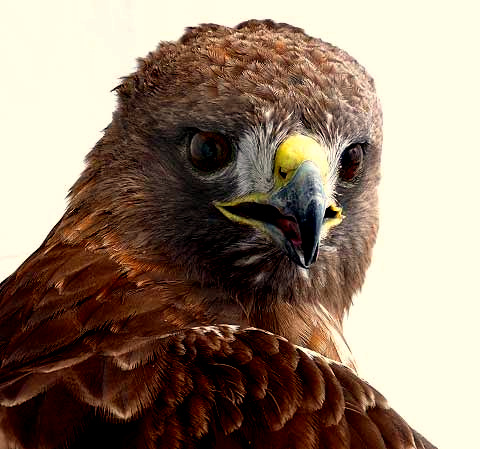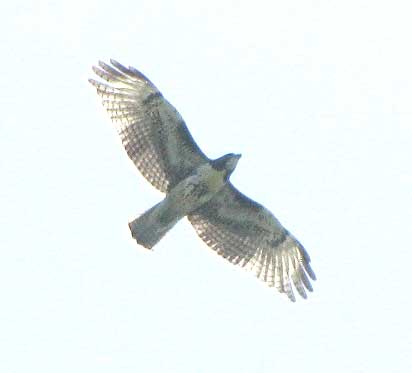Excerpts from Jim Conrad's
Naturalist Newsletter
from the July 28, 2013 Newsletter issued from the Frio Canyon Nature Education Center in the valley of the Dry Frio River in northern Uvalde County, southwestern Texas, on the southern border of the Edwards Plateau; elevation ~1750m (~5750 ft); N29.62°, W99.86°; USA
IMMATURE HAWK
The Dry Frio River Valley is a good place to see a fine selection of hawks. Michael Overton's "Birds of Uvalde County, Texas" lists 20 species under the heading "Kites, Hawks, Eagles & Allies," including such interesting ones as Swallow-tailed, White-tailed and Mississippi Kites, Common Black-Hawk, and Harris's, Short-tailed, White-tailed, Zone-tailed, and Ferruginous Hawks. Among those 20 species only two are noted as common throughout the year, and that's the Harris's and Red-tailed Hawks. I'm surprised to see the Harris's described as so common because in this valley I've not seen one. However, every day Red-tailed Hawks circle above us, often screaming their high-pitched, blood-curdling, snarling call from high up.

A few months ago my neighbor Phred drove upon an immature Red-tail feeding at the road's edge. The surprised hawk flew right into the path of Phred's car, despite efforts to avoid him. The hawk tumbled to the road's edge with a wing dragging the ground, unable to fly. After being bandaged up according to directions on the Internet he was provided a perch in a little greenhouse. Mindful of federal law prohibiting the keeping of bird predators, the hawk was free to fly through the greenhouse door whenever he wanted. However, with a drooped wing and free food every day, he stayed... until one morning he did fly out, sailing into the woods. He'd shown no signs of being able to fly, and his wing still seemed to drag, so this departure was unexpected. We've often wondered if any of the Red-tails always circling above the valley might be him. That portrait above, taken by Phred, shows our bird.
The plumages of immature hawks often differ drastically from the plumages of adults of their species, and at this time of year we see plenty of immatures. Therefore, it's worth learning the immature plumages.
For example, the other day a young hawk flew over the Center, as shown below:

Here the best bet is always that any circling hawk with broad, rounded wings and a fanned tail is a Red-tailed Hawk. However, this bird's tail not only is not reddish, but it bears faint, narrow bands.
Happily, patternings of dark spots on immature hawk bodies and wings are fairly consistent and predictable from species to species. On the bird in our picture, field marks to notice are the dark-tipped primary feathers at the wings' ends, an especially dark zone near the base of those primaries, the wings' white flight feathers having light barring, and the dark bar on the leading edge of the underwings.
These field marks inexorably lead us to the immature Red-tailed Hawk, BUTEO JAMAICENSIS, and so we learn that the tails of immature Red-tails when seen from below can indeed show faint, fine barring.
from the August 8, 2004 Newsletter issued from the woods a few miles east of Natchez, Mississippi, USA; elevation ~400ft (120m), ~N31.47°, ~W91.29°
GHOST-HAWK
Another powerful cold front barreled through here Thursday afternoon bringing a second shot of coolish air in two weeks. The storm announcing the front was impressive, a really dark one with a well-defined boundary between the rainfall below and the roiling clouds above.
Right during the windiest, darkest moments preceding the white curtain of rain's arrival here, a white-looking hawk came into view. The binoculars showed it to be a Red-tailed Hawk and really I can't say whether he was any paler than normal, or whether he just looked white because of the very dark background.
Whatever the case, that hawk presented a majestic, ghostly appearance. The wind must have been terrible where he was, for he was being blown before the storm like a sheet of newspaper high in the sky experiencing violent downdrafts, updrafts, and vortices. Not quite like a newspaper, though, because he had some control and -- this is the thing -- as with the young towhee, his body language told me that he was having a lot of fun.
On the ground other birds were frantically seeking shelter, flying hard and low, the sense of emergency clearly indicated in their demeanors. But that white specter in the fearful-looking sky for the few seconds he remained in view was like a teenager catching his first good wave with a surfboard. He had enough control to descend if he wanted, but this is the season when hawks get the wandering urge, so maybe he just didn't want to. Maybe this storm just struck some kind of chord in him that said "Instead of scrambling for shelter like a mouse, just latch onto this mightiness, go with it, and exult in being a free-sky hawk!"
It'd been one of those super-sultry afternoons when you have to fight to keep focused and busy, so that storm with its sudden gushes of coolness and powerful animations all around me, and that ghost-hawk performing one broad laugh all the way across the sky, was just what I needed.
from the August 3, 2007 Newsletter issued from from Sierra Gorda Biosphere Reserve, QUERÉTARO, MÉXICO
GHOST-HAWK
Last weekend I hitched a ride on the recycling truck up to El Madroño, to where the main highway crosses the Eastern Sierra Madre before plummeting into the Gulf lowlands. This time instead of climbing into the cloudforest I headed to a lush little cove in a valley where trees had been cut from a house-size spot and grasses and wildflowers had grown back, forming a little meadow. In the afternoon with the sky intensely blue, the sun stinging my skin but the air cool, I couldn't resist lying in the grass and just watching clouds.
The first thing to draw my attention, though, wasn't a cloud, but a Black Vulture circling me. Or, was it a Black Vulture at all? It certainly looked like one, but somehow it flew differently. The binoculars, moreover, didn't show white "window patches" on the wings, which Black Vultures have. And the bird's tail feathers backlit by sunlight glowed with a bright, rusty hue. The bird was a black Red-tailed Hawk, and it was circling with another hawk of the usual whitish/light-gray color.
I've seen black Red-tailed Hawks before, but not often. The last one I remember observing was soaring around the crater of the volcano called Nevado Toluca in central Mexico, at 15,036-ft (4583 m) in elevation. I'm getting the impression that this "dark morph" most frequently appears at high elevations.
Many pictures of dark Red-tailed Hawks can be found on the Internet, but I can't find any showing exactly what I saw last weekend. Both last weekend's bird and the volcano one looked perfectly black to me, except for the reddish tail. The ones on the Internet show pale spots and blotches. Maybe my birds, seen so starkly against the brilliant, high-elevation sky, showed up as sheer silhouettes even though they had some white feathers.
The Red-tail's "dark morph" has its own name, the Harlan's Red-tailed Hawk.
Seeing a normal pale Red-tail circling with the black morph, you can't help wondering what's to keep the much rarer black form from disappearing as its genetic material mingles with and disperses into the much more abundant pale-bird gene pool. I don't know what the deal is with Red-tails, but it's understood that the appearance of blue-morph Snow Geese (the Blue Goose recognized as a distinct species in older books) is controlled by a single gene, with dark being partially dominant over white. If a dark morph mates with a normal white goose, the offspring will all be dark. If two white geese mate, they have only white offspring. If two dark geese mate, they have mostly dark offspring, but some white ones.